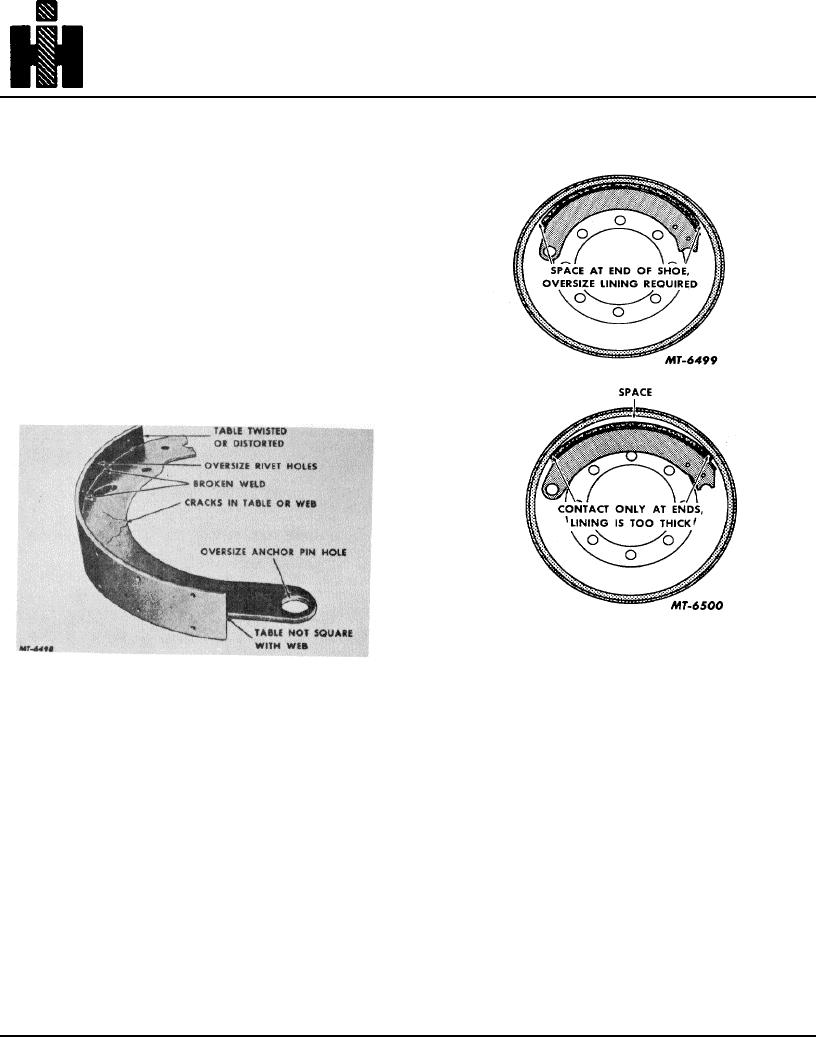
TRUCK SERVICE MANUAL
BRAKES-AIR
Wherever brake linings or blocks are worn to within 1/16"
oversize lining is required (Fig. 12. If lining selected is
of rivets, the brake shoes must be removed and relined.
too thick, only the ends of the lining will contact the drum.
It is recommended that all the brakes be relined at the
see Fig. 13.
same time since this will maintain balanced braking on
the vehicle. If complete replacement is not desirable or
necessary, be sure that all lining on one axle (both sides)
is replaced at the same time.
When removing worn lining from shoes, drill out old
rivets if possible to prevent distorting shoe table. After
the old linings are removed from the shoes, the shoes
should be cleaned and buffed to remove all dirt and
grease. Grease is one of the greatest deteriorating
agents of lining.
Fig. 12 Lining Selected too Thin
Examine shoes carefully and discard those which have
any defects as shown in Fig 11.
Fig. 13 Lining Selected Too Thick
The lining must be installed on the shoe so that it fits
Fig. 11 Defects to be Looked for on Brake Shoe
smoothly and evenly, contacting the shoe throughout the
entire radius. If gaps occur between the rivets, difficulty
Discard used lock washers after removing lining bolts.
will be met in adjusting the brakes in that "spongy" or
Use new washers when installing new lining. Replace
rubbery pedal may occur which makes satisfactory brake
bolts and nuts if signs of distortion or wear are present.
application impossible.
Care should be used in selecting the correct thickness of
To insure complete contact and avoid gaps between
lining for each brake shoe and drum. Usually the
lining and shoe, secure lining to shoe with "C" clamp so
standard thickness will be used. If the drum has been
that rivet or bolt holes are in alignment. Position "C"
turned or become worn, increasing the diameter,
clamp as close to the holes as possible, clamping the
oversize lining may be required.
lining firmly in place.
If it is not known how much material has been removed
When securing brake lining to shoes, start with the
from the drum during the turning operation, the following
center rivet or bolt and work toward the ends as shown in
simple test may be used to help select the proper lining.
Fig. 14. When securing brake block lining to shoe, use
the sequence as shown in Fig. 15. Always use new lock
Hold standard size lining snugly to the shoe, position it
washers when installing bolt on lining and tighten nuts to
against the inner surface of the drum, forcing it into
20-25 ft. lbs. torque.
contact with the drum surface. The lining is now in the
same position as during a brake application. If space is
noted at the ends of the shoe (shoe can be rocked),
189

